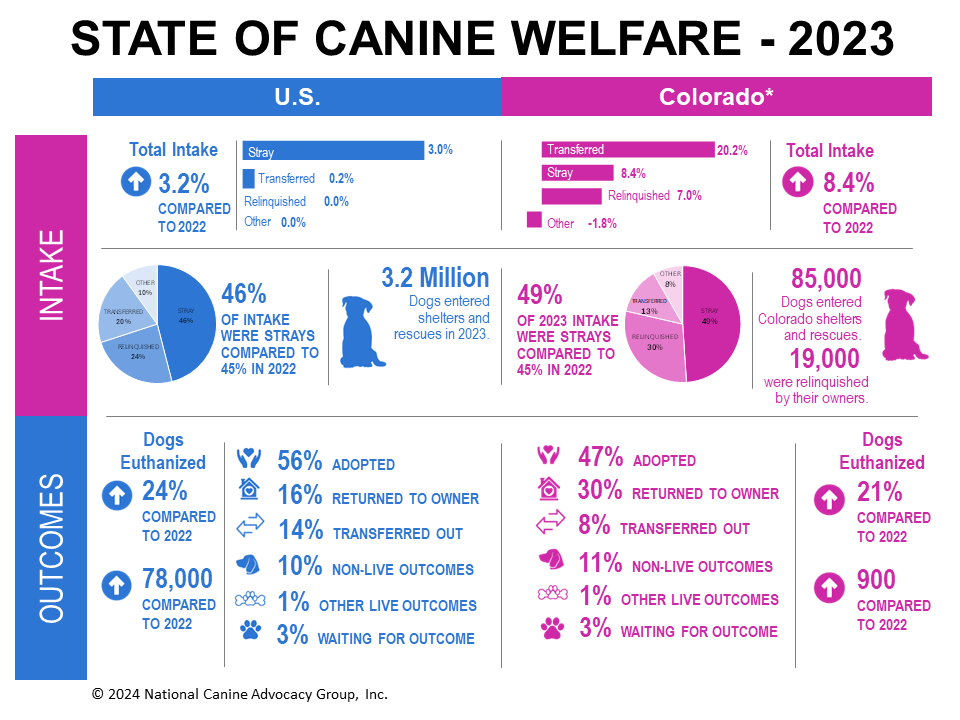

THE ASK
2023 was not a good year for dogs in Colorado or nationally. Shelter intake is up, adoptions are down, and euthanasia is on the rise. We cannot change the past that got us to this desperate point, but we can change the future!
70% of dogs entering shelters nationwide are either STRAYS or OWNER RELINQUISHMENTS. By reducing this number, we can significantly reduce the rate of euthanasia in our shelters. Here’s what you need to know.
STRAYS: Dogs can roam far from home and, if picked up, could end up in an animal shelter miles away. If your dog gets loose, check all the shelters for them, not just the closest. Most shelters post stray dogs in the custody on their websites and check them often. There is a limited number of days you have to collect your dog before they become the property of the animal shelter to do with what they think is best (in Colorado it’s 5 days). If they determine the dog is not adoptable and cannot be rehabilitated, the outcome will likely be euthanasia.
Keep your dog from wandering by:
- Spaying/neutering: unaltered dogs are driven by hormones to wander. Spaying or neutering your pet when he is young removes the hormonal desire to roam.
Build a fence around your yard: dogs should not be allowed to roam freely in most situations. Walk the perimeter of your fence frequently to check for potential escape routes. - Teach your dog basic commands: teaching your dog to obey basic commands can be useful if he decides to chase something that catches his eye. Most importantly, teach him the commands “come” and “stay.”
- Provide adequate exercise and enrichment opportunities: dogs with pent-up physical and/or mental energy are more likely to run away. Provide opportunities every day to stimulate your dog physically and mentally.
- Keep your pet safe from loud noises: shelters overflow with dogs who run away during loud festivities like those involving fireworks. An unexpected loud noise can make your dog panic and bolt before you realize he’s gone.
- Prepare your pet for the worst: even if you take appropriate precautions, your dog still might run away, so prepare for the worst and ensure he is properly identified. Microchips are the best assurance for identification and need to be used in combination with a collar for the best chance of finding a lost pet. Make a point now of remembering to update your contact information with the company that keeps records for the microchip every time there is a change in your contact information. It can make the difference between your pet being returned to you or staying lost to you forever.
OWNER RELINQUISHMENTS: Millions of dogs are abandoned by their owners at animal shelters every year.
The vast majority of relinquishments are driven by two solvable problems, the primary of which is a dog is showing unwanted behavior. Research suggests many relinquishing owners would keep their dogs if there was support available to help solve behavioral issues. Owners should contact their shelter for resources to deal with behavioral problems and many dog trainers offer discounted rates when a relinquishment is being considered by the owner.
Owners’ failure to properly research/plan for having a dog also drives hundreds of thousands of relinquishments every year. Reasons like not having enough time; overwhelm with the responsibility; financial burden, particularly related to older dogs; unwanted litters; and boredom/disinterest in the dog drive hundreds of thousands of relinquishments. Owners may be under the false impression that their dog would “never be euthanized” but many of these dogs never make it out of the shelter.
Things to consider before getting a dog or puppy include:
- Can You Commit the Time: will you have the time to walk your dog, provide other enrichment activities, and groom your dog? If the answer is no, and you have no one who can perform those essential tasks, you should stop right here.
- Will Your Pet Fit Your Lifestyle: Do your research and choose wisely. Get to know the breed you are interested in and be open to changing your mind if it doesn’t fit your ability to provide for its temperament. Be realistic about whether that cute little puppy is really the best choice versus an adult dog.
- Do You Have the Financial Resources: consider the all-in cost of dog ownership. The cost initially paid for a dog, whether from a breeder, rescue, shelter, or classified ad is generally very small compared to the cost of maintaining a dog through his lifetime. Things like medical expenses for immunizations, parasite control, neutering/spaying, dental care, the cost of feeding a dog, training, boarding, and grooming all add up.
